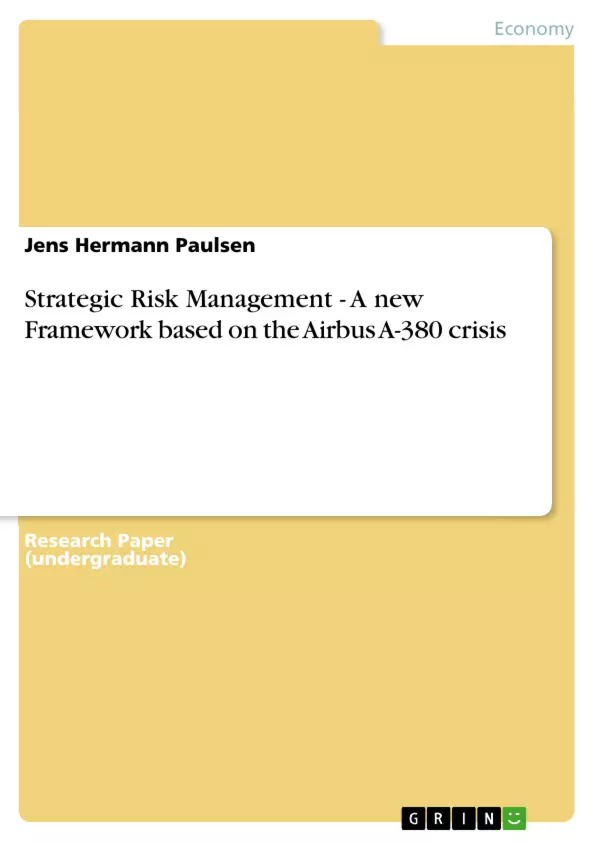The paper will outline major flaws in Airbus’s risk management and thereby identify reasons for the production delay of the Airbus 380.
The Airbus A-380 project was launched in 2000 and remains the largest project in the company’s history. The Airplane was designed to carry up to 853 passengers and offer 50 per cent more floor surface than any other passenger aircraft. The total cost of development summed up to € 12 billion and it was planned to deliver the first aircraft to Singapore Airlines in 2005. In reality the first aircraft was delivered in 2007. The 2 years delay of the delivery of the first Airbus 380 eventually added up to an estimated sum of €4.8 billion loss in profit.
The reason for this delay was that the pre-assembled wirings produced in Germany failed to fit into the frame when the plane was to assemble in France. This misfit can be attributed to the fact that the German plant used CATIA 4 (CATIA is a computer-aided design software) which was only able to show the plane as a two dimensional model while France used CATIA 5 which displayed the plane in three dimensions.
Inhaltsverzeichnis (Table of Contents)
- 1. Introduction
- 1.1 Setting the scene
- 1.2 Hypothesis and Research Questions
- 1.3 Methodology
- 1.4 Outline of the Paper
- 1.5 Airbus the company
- 2. Analysis
- 2.1 The A-380 crisis
- 2.2 Airbus risk landscape
- 2.2.1 Conclusion risk landscape
- 2.3 Risk Management at EADS
- 2.3.1 Conclusion Risk Management Structure
- 2.4 Culture at Airbus
- 3. Discussion
- 3.1 Risks that led to the crisis
- 3.2 Airbus current risk management (2003-2007)
- 3.3 What are the flaws (and how could the system be redesigned?)
- 3.3.1 Why culture matters
- 3.4 Suggestions for an culture embracing design
- 3.4.1 Applying SRC to Airbus
- 4. Conclusion
Zielsetzung und Themenschwerpunkte (Objectives and Key Themes)
This paper examines the flaws in Airbus's risk management system and analyzes the reasons behind the production delay of the Airbus 380. It aims to understand how a major misalignment occurred despite the existence of a risk management system. The paper explores the potential connections between strategic risk management and corporate culture.- Strategic Risk Management and Corporate Culture
- The Airbus A-380 Crisis
- Risk Management Systems in Large Corporations
- The Importance of Culture in Business Operations
- Case Study Analysis: Airbus
Zusammenfassung der Kapitel (Chapter Summaries)
The first chapter provides an introduction to the topic, setting the stage for the analysis. It defines the research question, outlines the methodology, and introduces Airbus as a company. Chapter two dives deeper into the analysis of the A-380 crisis, examining Airbus's risk landscape and the risk management structure at EADS. It also discusses the corporate culture at Airbus. Chapter three delves into the specific risks that led to the A-380 crisis, reviewing the flaws in Airbus's risk management system and exploring how to redesign it. Chapter four, the conclusion, is not included in this preview.Schlüsselwörter (Keywords)
This paper focuses on strategic risk management, corporate culture, Airbus, the A-380 crisis, risk management systems, case study analysis, and the impact of culture on business operations. The analysis delves into the relationship between risk management systems and organizational culture, utilizing the Airbus A-380 crisis as a case study to illustrate the potential consequences of misalignment.- Quote paper
- BA Sc. Jens Hermann Paulsen (Author), 2011, Strategic Risk Management - A new Framework based on the Airbus A-380 crisis, Munich, GRIN Verlag, https://www.grin.com/document/204406



